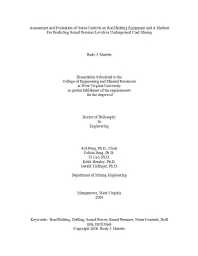Mining Publication: Assessment and Evaluation of Noise Controls on Roof Bolting Equipment and a Method for Predicting Sound Pressure Levels in Underground Coal Mining
Original creation date: January 2006
Over-exposure to noise remains a widespread and serious health hazard in the U.S. mining industries despite 25 years of regulation. Every day, 80% of the nation's miners go to work in an environment where the time weighted average (TWA) noise level exceeds 85 dBA and more than 25% of the miners are exposed to a TWA noise level that exceeds 90 dBA, the permissible exposure limit (PEL). Additionally, MSHA coal noise sample data collected from 2000 to 2002 show that 65% of the equipment whose operators exceeded 100% noise dosage comprise only seven different types of machines; auger miners, bulldozers, continuous miners, front end loaders, roof bolters, shuttle cars (electric), and trucks. In addition, the MSHA data indicate that the roof bolter is third among all the equipment and second among equipment in underground coal whose operators exceed 100% dosage. A research program was implemented to: 1) determine, characterize and to measure sound power levels radiated by a roof bolting machine during differing drilling configurations (thrust, rotational speed, penetration rate, etc.) and utilizing differing types of drilling methods in high compressive strength rock media (>20,000 psi). The research approach characterized the sound power level results from laboratory testing and provided the mining industry with empirical data relative to utilizing differing noise control technologies (drilling configurations and types of drilling methods) in reducing sound power level emissions on a roof bolting machine; 2) distinguish and correlate the empirical data into one, statistically valid, equation, in which, provided the mining industry with a tool to predict overall sound power levels of a roof bolting machine given any type of drilling configuration and drilling method utilized in industry; 3) provided the mining industry with several approaches to predict or determine sound pressure levels in an underground coal mine utilizing laboratory test results from a roof bolting machine and 4) described a method for determining an operators' noise dosage of a roof bolting machine utilizing predicted or determined sound pressure levels.
Authors: RJ Matetic
Dissertation - January 2006
NIOSHTIC2 Number: 20031415
Morgantown, WV: West Virginia University 2006 Jan; :1-193
See Also
- Acoustic Assessment of Pneumatic and Electric Jackleg Drills used in the Mining Industry
- Analysis of a Mechanism Suspension to Reduce Noise from Horizontal Vibrating Screens
- A Control Suite to Reduce Roof Bolting Machine Drilling Noise
- Determining Underground Roof Bolting Machine Operators Noise Exposure Using Laboratory Results
- The Evolution of Drill Bit and Chuck Isolators to Reduce Roof Bolting Machine Drilling Noise
- Hearing Loss Prevention in Mining - 2005
- A Noise Control for A Roof Bolting Machine: Collapsible Drill Steel Enclosure
- Sound Power Level Study of a Roof Bolter
- A Technique for Estimating the Sound Power Level Radiated by Pneumatic Rock Drills and the Evaluation of a CSIR Prototype Rock Drill with Engineering Noise Controls
- Technology News 539 - Identifying The Benefits Of Engineering Noise Controls Through A Business Case
- Page last reviewed: 9/21/2012
- Page last updated: 9/21/2012
- Content source: National Institute for Occupational Safety and Health, Mining Program


 ShareCompartir
ShareCompartir
